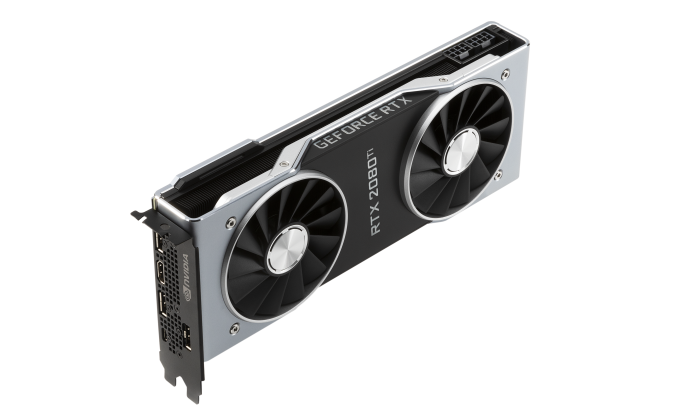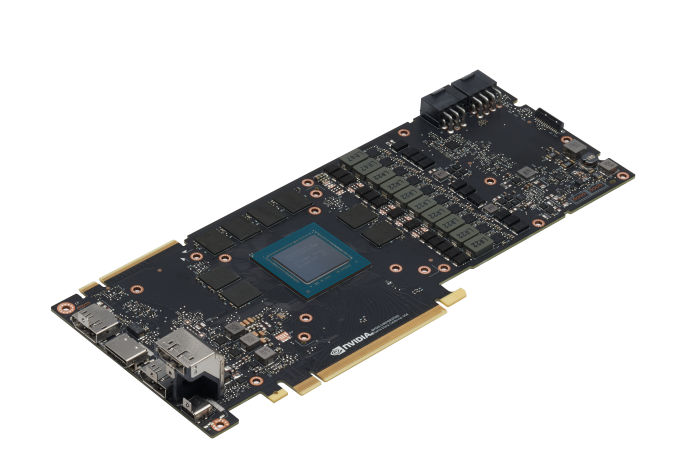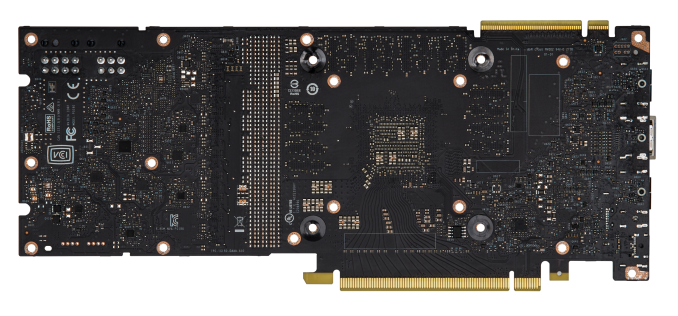The NVIDIA GeForce RTX 2080 Ti & RTX 2080 Founders Edition Review: Foundations For A Ray Traced Future
by Nate Oh on September 19, 2018 5:15 PM EST- Posted in
- GPUs
- Raytrace
- GeForce
- NVIDIA
- DirectX Raytracing
- Turing
- GeForce RTX
Meet The GeForce RTX 2080 Ti & RTX 2080 Founders Editions Cards
Moving onto the design of the cards, we've already mentioned the biggest change: a new open air cooler design. Along with the Founders Edition specification changes, the cards might be considered 'reference' in that they remain a first-party video card sold direct by NVIDIA, but strictly-speaking they are not because they no longer carry reference specifications.
Otherwise, NVIDIA's industrial design language prevails, and the RTX cards bring a sleek flattened aesthetic over the polygonal shroud of the 10 series. The silver shroud now encapsulates an integrated backplate, and in keeping with the presentation, the NVLink SLI connectors have a removable cover.
Internally, the dual 13-blade fans accompany a full-length vapor chamber and component baseplate, connected to a dual-slot aluminum finstack. Looking at improving efficiency and granular power control, the 260W RTX 2080 Ti Founders Edition features a 13-phase iMON DrMOS power subsystem with a dedicated 3-phase system for the 14 Gbps GDDR6, while the 225W RTX 2080 Founders Edition weighing in with 8-phases main and 2-phases memory.
As is typical with higher quality designs, NVIDIA is pushing overclocking, and for one that means a dual 8-pin PCIe power configuration for the 2080 Ti; on paper, this puts the maximum draw at 375W, though specifications-wise the TDP of the 2080 Ti Founders Edition against the 1080 Ti Founders Edition is only 10W higher. The RTX 2080 Founders Edition has the more drastic jump, however, with 8+6 pins and a 45W increase over the 1080's lone 8 pin and 180W TDP. Ultimately, it's a steady increase from the power-sipping GTX 980's 165W.
One of the more understated changes comes with the display outputs, which thanks to Turing's new display controller now features DisplayPort 1.4 and DSC support, the latter of which is part of the DP1.4 spec. The eye-catching addition is the VR-centric USB-C VirtualLink port, which also carries an associated 30W not included in the overall TDP.
Something to note is that this change in reference design, combined with the seemingly inherent low-volume nature of the Turing GPUs, cuts into an often overlooked but highly important aspect of GPU sales: big OEMs in the desktop and mobile space. Boutique system integrators will happily incorporate the pricier higher-end parts but from the OEM’s perspective, the GeForce RTX cards are not just priced into a new range beyond existing ones but also bringing higher TDPs and no longer equipped with blower-style coolers in its ‘reference’ implementation.
Given that OEMs often rely on the video card being fully self-exhausting because of a blower, it would certainly preclude a lot of drop-in replacements or upgrades – at least not without further testing. It would be hard to slot into the standard OEM product cycle at the necessary prices, not to mention the added difficulty in marketing. In that respect, there is definitely more to the GeForce RTX 20 series story, and it’s somewhat hard to see OEMs offering GeForce RTX cards. Or even the RT Cores themselves existing below the RTX 2070, just on basis of the raw performance needed for real time ray tracing effects at reasonable resolutions and playable framerates. So it will be very interesting to see how the rest of NVIDIA’s product stack unfolds.
















337 Comments
View All Comments
Dribble - Thursday, September 20, 2018 - link
The DLSS basically gives you a resolution jump for free (e.g. 4k for 1440p performance) and is really easy to implement. That's going to take off fast and probably means even the 2070 will be faster then the 1080Ti in games that support it.Lolimaster - Saturday, September 22, 2018 - link
No not free, everyone can see the blurry mess the renamed blur effect is.Inteli - Saturday, September 22, 2018 - link
TIL that when you stop isolating variables in a benchmark, a lower-end card can be faster than a higher-end card.tamalero - Wednesday, September 19, 2018 - link
Die size is irrelevant to consumers. They see price vs performance. not how big the silicon is.AMD was toasted for having hot slow chips. many times.. so did nvidia.. big and hot means nothing if it doesn't perform as expected for the insane prices they 're asking for.
Yojimbo - Wednesday, September 19, 2018 - link
Die size is not irrelevant to consumers because increased die size means increased cost to manufacture. Increased cost to manufacture means a pressure for higher prices. The question is what you get in return for those higher prices.People like what they know... what they are used to. If some new AA technique comes along and increases performance significantly but introduces visual artifacts it will be rejected as a step backwards. But if a new technology comes along that has a significant performance cost yet increases visual quality much more significantly than the aforementioned artifacts decrease it, people will also have a tendency to reject it. That is, until they become familiar with the technology... That's where we are with RTX. No one can become familiar with the technology when there are no games that make use of it. So trying to judge the value of the larger die sizes is an abstract thing. In a few months the situation will be different.
Personally, I think the architecture will be remembered as one of the biggest and most important in the entire history of gaming. There is so much new technology in it that some of it barely anyone is saying much about (where have you heard about texture space shading, for example?). Several of these technologies will have their greatest benefits with VR, and if VR had taken off people would be marveling about this architecture immediately. But I think that VR will eventually take off, and I think several of these technologies will become the standard way of doing things for the next several years. They are new and complicated for developers, though. Only a few developers are prepared to take advantage of the stuff today. It's going to be some time before we really can put the architecture into its proper historical perspective.
From the point of view of a purchase today, though, it's a bit of an unknown. If you buy a card now and plan to keep it for 4 years, I think you'd be better off getting a 20 series than a 10 series. If you buy it and keep it for 2 years, then it's a bit less clear, but we'll have a better idea of the answer to that question in 6 months, I think.
I do think, though, that if an architecture with this much new stuff were introduced 20 years ago everybody, including games enthusiast sites like Anandtech, would be going gaga over it. The industry was moving faster then and people were more optimistic. Also the sites didn't try to be so demure. Hmm, gaga as the opposite of demure. Maybe that's why she's called Lady Gaga.
Santoval - Wednesday, September 19, 2018 - link
I agree that this might be the most game-changing graphics tech of the last couple of decades, and that the future belongs to ray-tracing, but I also think that precisely due to the general uncertainty and the very high prices Nvidia might suffer one of their biggest sales slumps this generation, if not *the* biggest. They did not handle the launch well : it is absurd to release a new series with zero ray-traced, DLSS supporting or mesh shaded games at launch.Their extensive NDAs, lack of information and ban on benchmarks between the Gamescom pre-launch and the actual launch, despite going live with (blind faith based) preorders during that window, was also controversial and highly suspicious. It appears that Nvidia gave graphics cards to game developers very late to avoid leaks, but that resulted in having no RTX supporting games at launch. They thought they could not have it both ways apparently, but choosing that over having RTX supporting games at launch was a very risky gamble.
Since their sales will almost certainly slump, they should release 7nm based graphics cards (either a true 30xx series or Turing at 7nm, I guess the latter) much sooner, probably in around 6 months. They might have expected a sales slump, which is why they released 2080Ti now. I suppose they will try to avoid it with aggressive marketing and somewhat lower prices lately, but it is not certain they'll succeed.
eddman - Thursday, September 20, 2018 - link
Would you've still defended this if it was priced at $1500? How about $2000? Do you always ignore price when new tech is involved?The cards, themselves, aren't bad. They are actually very good. It's their pricing.
These cards, specifically 2080 Ti, are overpriced compared to their direct predecessors. Ray tracing, DLSS, etc. etc. they still do not justify such prices for such FPS gains in regular rasterized games.
A 2080 Ti might be an ok purchase for $850-900, but certainly not $1200+. Even 8800 GTX with its new cuda cores and new generation of lighting tech launched at the same MSRP as 7800 GTX.
These cards are surely more expensive to make, but there is no doubt that the biggest factor for these price jumps is that nvidia is basically competing with themselves. Why price them lower when they can easily sell truckloads of pascal cards at their usual prices until the inventory is gone.
Andrew LB - Thursday, September 20, 2018 - link
You, like so many others don't get it. nVidia has re-worked their product lines. Didn't you notice how the Ti came out at the same time as the 2080? You might also notice that Titan is now called Titan V (volta) and not GTX Titan. Titan is now in its own family of non-gaming cards and that is reflected in the driver section on their site. They now have titan specific drivers.Here, watch this. Jay explains it fairly well.
https://youtu.be/5XRWATUDS7o?t=6m2s
eddman - Thursday, September 20, 2018 - link
You took an opinion and decided it's a fact. It's not. That guy is not the authority on graphics cards.There is no official word that titan is now 2080 Ti. Nvidia named that card 2080 Ti, it has a 102 named chip. Nvidia themselves constantly compare it to 1080 Ti, which also has a 102 named chip, therefore it's the successor to 1080 Ti and it's very normal to expect similar pricing.
Don't worry, there will be a Titan turing, considering that 2080 Ti does not even use the fully enabled chip.
It's really baffling to see people, paying customers, defending a $1200 price tag. It is as if you like to be charged more.
eddman - Thursday, September 20, 2018 - link
$1000, but it's still too high, and you cannot find any card at that price anyway.